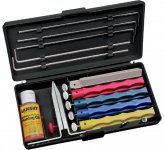I use my stainless chef's knife for just about everything in the kitchen.
I bought a Lansky kit.

It takes too much time for me to set it up and use it. I have only used it a few times.
Generally, I use a stainless honing rod to keep it sharp, but it doesn't make it razor sharp, and sometimes when I am done, it isn't much better than when I started.
I decided to try some green stainless steel polishing compound I got at Harbor Freight, and instead of lapping it with a leather strap, I use paper spackling tape as a strap.
So after using the honing rod, I lie the tape on a flat surface, rub some compound onto it, and then stroke the blade across it. It only takes a little bit of work before the green polish is black and the blade is sharp.

I bought a Lansky kit.
It takes too much time for me to set it up and use it. I have only used it a few times.
Generally, I use a stainless honing rod to keep it sharp, but it doesn't make it razor sharp, and sometimes when I am done, it isn't much better than when I started.
I decided to try some green stainless steel polishing compound I got at Harbor Freight, and instead of lapping it with a leather strap, I use paper spackling tape as a strap.
So after using the honing rod, I lie the tape on a flat surface, rub some compound onto it, and then stroke the blade across it. It only takes a little bit of work before the green polish is black and the blade is sharp.
Attachments
Last edited:



